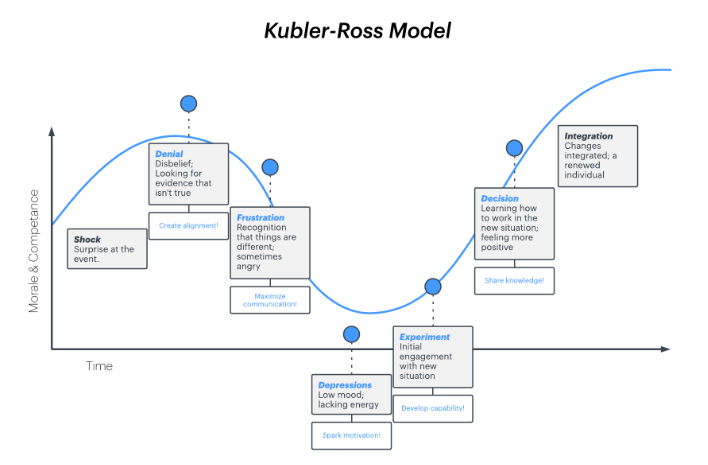Change Management
The term Change Management is very easily and clearly described in its own name as The task of managing change;
It entails thoughtful planning and sensitive implementation, and above all, consultation with, and involvement of, the people affected by the changes.
Change management is a systematic approach to dealing with specific change, both from the perspective of an organization and on the individual level. (searchsmb.com)
Within these definitions Change Management can be related to the subject of redundancy/job loss or bereavement, a shock or emotional trauma of any kind. Job loss as an example, is a circumstance where immense Change has been implied and is in need of sensitive implementation to ensure a conclusion as smooth as possible. Redundancies are not commonly associated with thoughtful planning but the response in handling redundancies (particularly for those left behind) definitely should be associated with this.
Mergers/ Acquisitions/Redundancies are not often handled very well. Companies employ their heads of operations or a vice president of something or other to oversee the change but it’s mostly a disaster. To retain your best talent, you need a professional. This is where Change management can contribute to assisting with change with lucidity. When we first recognise the importance of managing change correctly throughout a time like this; it is then, that light can be seen at the end of the tunnel.
 The Definition of Change is: To make or become different.
The Definition of Change is: To make or become different.
CHANGE can be created in those two different ways.
The first aspect of Change can be one that is thrown onto us, perhaps affiliated with when the situation Becomes Different. This is a change in which we ourselves have not created because it has been given to us against our will whether by another person or a circumstance.
OR the second aspect of Change can be the one that is controlled and instigated by us, where it is our decision to MAKE SOMETHING DIFFERENT, whether it is a change of job, or house or relationship. This type of Change can be a wonderful and healthy thing but like most things needs to be made sure our reason for change is a rational decision and one that will further help us not restrict us.
In terms of a merger or an acquisition the most common change is the one that is thrown upon us, a Change that is against our will, when a situation become’s different. Change is an uncomfortable situation. Your employees will watch you with keen interest and one slip up or mismanagement in handling any aspect of the change and trust, loyalty and motivation goes out of the window.
Bad news needs even more careful management than routine change.
There are three vital steps in the change management process that can pull you out of losing massive morale:-
- Involve and consider the right people –
Consulting with your team as well as consulting with experts who can help frame messages properly does not weaken your position – it strengthens it.
It takes more than a decade to master the art of change language/persuasion and communication. You are not expected to be an expert at it. Get help. Find an expert who can come in, craft the strategy and empower you to deliver it. You cannot afford to lose momentum or your best people because you are not sure how to communicate what is happening. People are also wiser than you think and they know if you are being weird that they cannot trust you.
- Change should be carefully considered –
Change needs to be understood and managed in a way that people can cope effectively with it. When merging two organisations, what is your plan? How will you ensure that all parties are on the same page? How will you ensure that your best people are encouraged and excited by the change vs. feeling marginalised and terrified?
And thirdly
- Know your responsibility
Different types of change require different approaches. You may not have the privilege of being prepared for the changes in your life but you do have the privilege of preparing yourself in how to manage that change when it comes…
Resistance and Barriers to Change
A degree of resistance is normal since change is both disruptive and stressful. A degree of scepticism can be healthy especially where there are weaknesses in the proposed changes. Resistance will also impede the achievement of organisational objectives.
- Individuals are more concerned with the implications for themselves
- Communications problems
- Inadequate information
- Sense of insecurity
- Different assessment of the situation
- Disagreement over the advantages and disadvantages of the change
- Structural inertia
- Existing power structures
- Resistance from work groups
- Failure of previous change initiatives
- Loyalty to existing relationships
- Failure to accept the need for change
- Insecurity
- Preference for the existing arrangements
- Break up of work groups
- Different person ambitions
- Fear of a loss of power, skills, income or the unknown…
- Redundancy
- Inability to perform as well in the new situation
- “My needs are already being met”
- “There is no justification for this change”
- “I don’t like the way they propose to do it”
- “The risks outweigh the benefits”
- “It will now be harder for me to meet my own needs”
- Change is often resisted because of failures in the way it is introduced
- Failure to explain the need for change
- Failure to provide information
- Failure to consult, negotiate and offer support and training
- Lack of involvement in the process
- Failure to build trust and sense of security
- Poor employee relations
Bringing in an expert is a wise move when there is alot at stake…

Leave a Reply